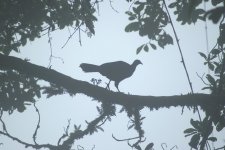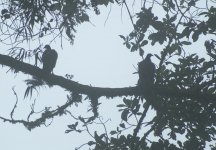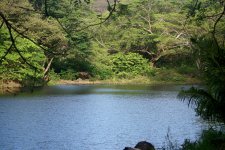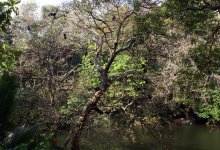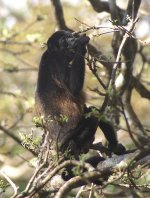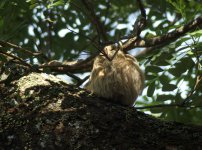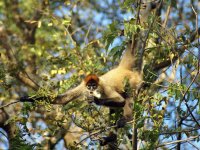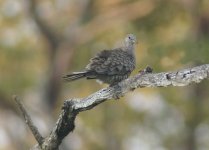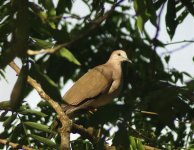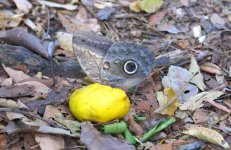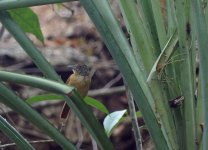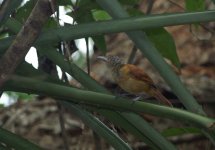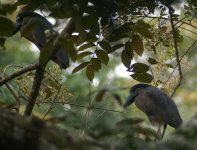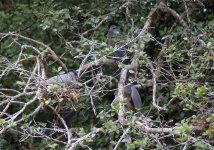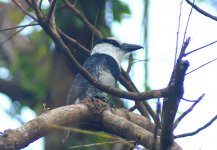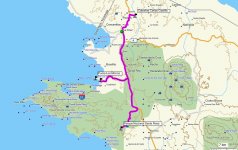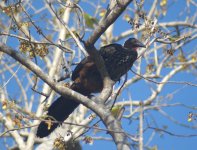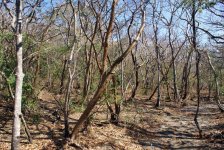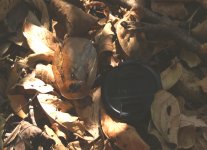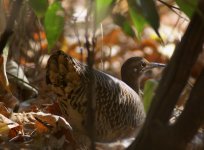-
Welcome to BirdForum, the internet's largest birding community with thousands of members from all over the world. The forums are dedicated to wild birds, birding, binoculars and equipment and all that goes with it.
Please register for an account to take part in the discussions in the forum, post your pictures in the gallery and more.
You are using an out of date browser. It may not display this or other websites correctly.
You should upgrade or use an alternative browser.
You should upgrade or use an alternative browser.
Costa Rica - Volcan Poas & Guanacaste (3 Viewers)
- Thread starter Peter C.
- Start date
More options
Who Replied?Peter C.
...just zis guy, you know?
Poas Volcano Lodge - an Afterword
(You may safely consider all of the next two post to be an [Aside]. Judging from the replies I have seen so far, it looks like I am mostly "preaching to the choir" here. But in case I still have any readers who are among the "unconverted," what follows may be a useful clarification).
Looking over the account I have written above, I realize I spilled a lot of (digital) ink complaining about the weather (and other trivialities). I am concerned that may have diluted the message I was trying to get across – especially for those of you who have never been to Costa Rica at all, and for whom this thread might be something you are reading for practical purposes (i.e., to make decisions on where to go for an upcoming trip). So I’ll state it explicitly: Poas Volcano Lodge is an extraordinarily good birding destination, even by the very high standards set by other Costa Rican locations that I have visited.
Now, I know that what constitutes an “extraordinarily good birding location” will differ from person to person. I don’t wish to open that discussion here; I am aware that my impressions of the place are going to be coloured by my own preferences. What I will do is to give my rationale for including Poas Volcano Lodge in this category, based on an anecdote. As a starting point, please consider for a moment the following image:
(You may safely consider all of the next two post to be an [Aside]. Judging from the replies I have seen so far, it looks like I am mostly "preaching to the choir" here. But in case I still have any readers who are among the "unconverted," what follows may be a useful clarification).
Looking over the account I have written above, I realize I spilled a lot of (digital) ink complaining about the weather (and other trivialities). I am concerned that may have diluted the message I was trying to get across – especially for those of you who have never been to Costa Rica at all, and for whom this thread might be something you are reading for practical purposes (i.e., to make decisions on where to go for an upcoming trip). So I’ll state it explicitly: Poas Volcano Lodge is an extraordinarily good birding destination, even by the very high standards set by other Costa Rican locations that I have visited.
Now, I know that what constitutes an “extraordinarily good birding location” will differ from person to person. I don’t wish to open that discussion here; I am aware that my impressions of the place are going to be coloured by my own preferences. What I will do is to give my rationale for including Poas Volcano Lodge in this category, based on an anecdote. As a starting point, please consider for a moment the following image:
Attachments
Peter C.
...just zis guy, you know?
All seen it now? Good.
What you just looked at was a photograph – a rather poor one – of a Black Guan. The Black Guan is large bird belonging to the cracid family, an exclusively new world group of (mostly) tropical distribution. The foggy picture does not really give you a good view of the bird, but I did see it very well on other occasions, and I assure you that it is a quite an impressive beast – large, glossy black all over, a small patch of deep steel-blue skin highlighting the face. Imagine a slighty underweight Wild Turkey crossed with a Raven, add just a tiny bit of antbird DNA for colour, and that’s the Black Guan.
So it’s quite a sight to see – but that’s not what makes Poas Volcano Lodge an “extraordinarily good birding location.”
It is also a very range-restricted species, only occurring in Costa Rica and west Panama. And within that range, it is only found in forests in the highlands. Therefore, there are only a relatively limited number of sites where a person can go and expect to see one, and Poas Volcano Lodge is one of those.
But this isn’t the reason either.
Furthermore, the Black Guan’s population is suffering, to some degree, from hunting pressure. So, they tend to retreat from areas where humans encroach – I felt very lucky that I was able get a photo of any kind of this bird.
That still isn’t the reason.
No, the real reason that Poas Volcano Lodge is such an extraordinarily good birding location is what doesn’t appear in the photo – the circumstances under which it was taken - which were as follows:
It was after returning from our hike down the Oakwood trail. I was in our room, having just changed into dry clothes – hadn’t even gotten around to putting shoes on yet. I opened the door, just to see what might be outside, and almost immediately, heard the characteristic rattle of the Guan’s display flight. Saw it land in a tree opposite – grabbed the camera from the bedside table – and shot the photo above, right through the doorframe. This all transpired within about five seconds.
Now, to my mind, anywhere that you can get a photo of a Black Guan, in your stocking feet, THAT is an “extraordinarily good birding location!”
Being able to shoot two Black Guans in these circumstances – well, that’s just overkill (if you’ll pardon the expression).
What you just looked at was a photograph – a rather poor one – of a Black Guan. The Black Guan is large bird belonging to the cracid family, an exclusively new world group of (mostly) tropical distribution. The foggy picture does not really give you a good view of the bird, but I did see it very well on other occasions, and I assure you that it is a quite an impressive beast – large, glossy black all over, a small patch of deep steel-blue skin highlighting the face. Imagine a slighty underweight Wild Turkey crossed with a Raven, add just a tiny bit of antbird DNA for colour, and that’s the Black Guan.
So it’s quite a sight to see – but that’s not what makes Poas Volcano Lodge an “extraordinarily good birding location.”
It is also a very range-restricted species, only occurring in Costa Rica and west Panama. And within that range, it is only found in forests in the highlands. Therefore, there are only a relatively limited number of sites where a person can go and expect to see one, and Poas Volcano Lodge is one of those.
But this isn’t the reason either.
Furthermore, the Black Guan’s population is suffering, to some degree, from hunting pressure. So, they tend to retreat from areas where humans encroach – I felt very lucky that I was able get a photo of any kind of this bird.
That still isn’t the reason.
No, the real reason that Poas Volcano Lodge is such an extraordinarily good birding location is what doesn’t appear in the photo – the circumstances under which it was taken - which were as follows:
It was after returning from our hike down the Oakwood trail. I was in our room, having just changed into dry clothes – hadn’t even gotten around to putting shoes on yet. I opened the door, just to see what might be outside, and almost immediately, heard the characteristic rattle of the Guan’s display flight. Saw it land in a tree opposite – grabbed the camera from the bedside table – and shot the photo above, right through the doorframe. This all transpired within about five seconds.
Now, to my mind, anywhere that you can get a photo of a Black Guan, in your stocking feet, THAT is an “extraordinarily good birding location!”
Being able to shoot two Black Guans in these circumstances – well, that’s just overkill (if you’ll pardon the expression).
Attachments
Motmot
Eduardo Amengual
(You may safely consider all of the next two post to be an [Aside]. Judging from the replies I have seen so far, it looks like I am mostly "preaching to the choir" here. But in case I still have any readers who are among the "unconverted," what follows may be a useful clarification).
Surely helps. Besides bf members, I'm sure there are often 'lurking' non members also reading this fab thread.
Cheers,
Eduardo
RobertaG
Well-known member
(You may safely consider all of the next two post to be an [Aside]. Judging from the replies I have seen so far, it looks like I am mostly "preaching to the choir" here. But in case I still have any readers who are among the "unconverted," what follows may be a useful clarification).
Surely helps. Besides bf members, I'm sure there are often 'lurking' non members also reading this fab thread.
Cheers,
Eduardo
Indeed - and even BF members can 'lurk', but I guess many, like me, with no experience to share tend to read, enjoy, but not post. Costa Rica is definitely on my wish list and I am thoroughly enjoying your account Peter - agree with Eduardo - it is fab.
Roberta
Steve G
RAINBIRDER
Excellent read & a real tease Peter.
Costa Rica has to be the biggest small country in the world -far too much to see in a single trip!!!
Birders on this side of the pond have tended to neglect the delights of Guanacaste however it makes a great base allowing visits to Santa Rosa, Palo Verde, Rincon de la Vieja with Monteverde & Arenal also being within easy reach.
The area around Heliconias lodge near Bijagua is especially worth mention as it can be reached from the Guanacaste coastal hotels for a day trip but really excels as a venue worthy of spending a few nights. Various Antbirds, Tody Motmot & the fabled Rufous-vented Ground-Cuckoo are all real possibilities here! See http://www.heliconiaslodge.com/
A short reminder to UK birders that "First Choice" now offer direct flight package deals from the UK to Guanacaste (Liberia) at competitive rates effectively opening up Costa Rica to the "family" birder.
Apologies for highjacking the thread > now back to Peter's great report to see what Guanacaste has to offer.
Costa Rica has to be the biggest small country in the world -far too much to see in a single trip!!!
Birders on this side of the pond have tended to neglect the delights of Guanacaste however it makes a great base allowing visits to Santa Rosa, Palo Verde, Rincon de la Vieja with Monteverde & Arenal also being within easy reach.
The area around Heliconias lodge near Bijagua is especially worth mention as it can be reached from the Guanacaste coastal hotels for a day trip but really excels as a venue worthy of spending a few nights. Various Antbirds, Tody Motmot & the fabled Rufous-vented Ground-Cuckoo are all real possibilities here! See http://www.heliconiaslodge.com/
A short reminder to UK birders that "First Choice" now offer direct flight package deals from the UK to Guanacaste (Liberia) at competitive rates effectively opening up Costa Rica to the "family" birder.
Apologies for highjacking the thread > now back to Peter's great report to see what Guanacaste has to offer.
Birdingcraft
Well-known member
Thanks especially for reporting on the Poas Volcano Lodge. The area around the lodge and Varablanca are on the top of my list of places to check out as they are fairly close to my house, are somewhat underbirded, and have a lot to offer. I am especially intrigued to visit after recently reading the life history write-up on Lovely Cotinga by Skutch. He studied this species (and others) in the Varablanca area. Although a lot of forest has been cut down since then, who knows- maybe they still occur in the area as there is still a good amount of habitat around.
I also strongly echo Steve G's Heliconias Lodge recommendation- although the weather is often bad, I always wish I could head up that way because like he mentioned, it's a good spot for Tody Motmot (only known, accessible site in CR), the ground-cuckoo, Spotted Antbird, Song Wren, Sharpbill, staked out owls, and various canopy species (including Lovely Cotinga) from their fantastic canopy bridges.
I also apologize if this is seen as a highjack- I don't mean to make it one.
I also strongly echo Steve G's Heliconias Lodge recommendation- although the weather is often bad, I always wish I could head up that way because like he mentioned, it's a good spot for Tody Motmot (only known, accessible site in CR), the ground-cuckoo, Spotted Antbird, Song Wren, Sharpbill, staked out owls, and various canopy species (including Lovely Cotinga) from their fantastic canopy bridges.
I also apologize if this is seen as a highjack- I don't mean to make it one.
Peter C.
...just zis guy, you know?
Indeed - and even BF members can 'lurk', but I guess many, like me, with no experience to share tend to read, enjoy, but not post. Costa Rica is definitely on my wish list and I am thoroughly enjoying your account Peter - agree with Eduardo - it is fab.
Roberta
Hi RobertaG.
You raise a good point; there are certain to be people who will come across this thread, who are not members of BF, and I had not thought of this (I was one, not so long ago!).
Anyway, thanks for the comments, on with the show.
Peter C.
...just zis guy, you know?
Costa Rica has to be the biggest small country in the world -far too much to see in a single trip!!!
Never mind that .. even four or five trips...!
The area around Heliconias lodge near Bijagua is especially worth mention as it can be reached from the Guanacaste coastal hotels for a day trip but really excels as a venue worthy of spending a few nights. Various Antbirds, Tody Motmot & the fabled Rufous-vented Ground-Cuckoo are all real possibilities here! See http://www.heliconiaslodge.com/
I also strongly echo Steve G's Heliconias Lodge recommendation- although the weather is often bad, I always wish I could head up that way because like he mentioned, it's a good spot for Tody Motmot (only known, accessible site in CR), the ground-cuckoo, Spotted Antbird, Song Wren, Sharpbill, staked out owls, and various canopy species (including Lovely Cotinga) from their fantastic canopy bridges.
Steve and Patrick, you are, I believe, the third and fourth individuals who have recommended Heliconias Lodge to me. It sounds wonderful, and I suspect it deserves a good long stay - no way I would be able to have even touched it on this trip. Hurts to read the list of possibilities - lots of life birds for me there....
Peter C.
...just zis guy, you know?
Cabañas Cañas Castilla - a brief Introduction
When I was first contemplating this trip, I took full advantage of my Birdforum membership, posting a question an open question in the "Costa Rica" forum – were I to be in Guanacaste for a few days, what would be the best place to stay?
I received a good number of thoughtful replies from some experienced “Costa Rica hands”, directing me to this hotel or that remote lodge; considered them all carefully; thanked my responders for their time (mmm ... at least, I hope I did); and then, being the contrary person I am, chose “none of the above”, and decided to go somewhere completely different! (There were reasons for this, however.)
Here follow some general impressions of the place we used as our Guanacaste base.
Cabañas Cañas Castilla is a basically a Costa Rican finca (cattle, oranges, trail horses) which happens to rent out really good cabins. It’s located just north of the town of La Cruz, in the far North-west of CR, only a few km. from Nicaragua. I had selected it as our “home” in Guanacaste, based mostly on three factors:
1) Relative proximity to Santa Rosa N.P.
2) A very positive review on TripAdvisor. Among other things attributes, the writer of this review praised it for having two qualities that are of great importance to us, namely (a) abundant wildlife and (b)quiet.
3) We could, for a small supplement of US$12/night, upgrade to a self-catering cabaña, with a refrigerator and stove. A very worthwhile investment, in my view, since it freed us completely to set our own schedule, with regards to meals. Even just having our own cooler, in this climate, was practically worth the money by itself.
Another positive aspect of Cabañas Cañas Castilla was its location, right on the banks of the Sonzapote River. In a dry region like this, permanent sources of fresh water are few and far between, so the river is a magnet for birds, as well as other wildlife.
The birds that stay close to the watercourses are not only the obvious ones you’d expect, like herons and shorebirds – we also found that for insectivorous birds like tyrant flycatchers, the number and variety dropped off very quickly the farther we moved away from a stream. Even the dry creekbeds (of which there were several cutting into the hillsides here) made for good birding, compared to other patches of forest without any kind of a creek. Now, this is just speculation, but my suspicion is that there’s just enough residual moisture in these “mini-gallery forests” to create a distinct micro-habitat, which is more supportive of insects than the truly dry forest type on the hillsides. This, in turn, makes for better foraging opportunities, and hence more birds, both in number and variety.
Cabañas Cañas Castilla is an excellent place for viewing non-avian wildlife as well. For example, it would be quite impossible to stay here without seeing (and hearing, oh, yes) a mantled howler or several. Spider Monkeys are also common, and while the two-toed sloth is a bit more of a challenge, I suspect that one could be found without too much trouble (as mentioned before, we had one living in the adjacent tree - all we had to do was walk out of our cabaña and look up!). There were also spectacled caiman resident in the river, but we never found one.
As with the birds, we found the monkeys and sloths to be more common in trees right along the river, compared to the trees inland a bit. I presume that, as with the birds, the trees that were near water presented better foraging opportunities.
Photos:
1) The Sonzapote from the lodge.
2) This is what we saw from right in front of our cabin - it's a wide-angle view, so those little dark things are actually (rather substantial!) Mantled Howler monkeys.
3) Mantled Howler feeding - and carrying an infant, which you can barely see, underneath her.
4) Your friendly neighbourhood Sloth-man; usually looked more like a bad toupée than an animal.
5) Spider Monkey - pretty fancy, for a mammal!
P.S. There will be a further short delay before the next post - I have to wrangle some more photos.
When I was first contemplating this trip, I took full advantage of my Birdforum membership, posting a question an open question in the "Costa Rica" forum – were I to be in Guanacaste for a few days, what would be the best place to stay?
I received a good number of thoughtful replies from some experienced “Costa Rica hands”, directing me to this hotel or that remote lodge; considered them all carefully; thanked my responders for their time (mmm ... at least, I hope I did); and then, being the contrary person I am, chose “none of the above”, and decided to go somewhere completely different! (There were reasons for this, however.)
Here follow some general impressions of the place we used as our Guanacaste base.
Cabañas Cañas Castilla is a basically a Costa Rican finca (cattle, oranges, trail horses) which happens to rent out really good cabins. It’s located just north of the town of La Cruz, in the far North-west of CR, only a few km. from Nicaragua. I had selected it as our “home” in Guanacaste, based mostly on three factors:
1) Relative proximity to Santa Rosa N.P.
2) A very positive review on TripAdvisor. Among other things attributes, the writer of this review praised it for having two qualities that are of great importance to us, namely (a) abundant wildlife and (b)quiet.
3) We could, for a small supplement of US$12/night, upgrade to a self-catering cabaña, with a refrigerator and stove. A very worthwhile investment, in my view, since it freed us completely to set our own schedule, with regards to meals. Even just having our own cooler, in this climate, was practically worth the money by itself.
Another positive aspect of Cabañas Cañas Castilla was its location, right on the banks of the Sonzapote River. In a dry region like this, permanent sources of fresh water are few and far between, so the river is a magnet for birds, as well as other wildlife.
The birds that stay close to the watercourses are not only the obvious ones you’d expect, like herons and shorebirds – we also found that for insectivorous birds like tyrant flycatchers, the number and variety dropped off very quickly the farther we moved away from a stream. Even the dry creekbeds (of which there were several cutting into the hillsides here) made for good birding, compared to other patches of forest without any kind of a creek. Now, this is just speculation, but my suspicion is that there’s just enough residual moisture in these “mini-gallery forests” to create a distinct micro-habitat, which is more supportive of insects than the truly dry forest type on the hillsides. This, in turn, makes for better foraging opportunities, and hence more birds, both in number and variety.
Cabañas Cañas Castilla is an excellent place for viewing non-avian wildlife as well. For example, it would be quite impossible to stay here without seeing (and hearing, oh, yes) a mantled howler or several. Spider Monkeys are also common, and while the two-toed sloth is a bit more of a challenge, I suspect that one could be found without too much trouble (as mentioned before, we had one living in the adjacent tree - all we had to do was walk out of our cabaña and look up!). There were also spectacled caiman resident in the river, but we never found one.
As with the birds, we found the monkeys and sloths to be more common in trees right along the river, compared to the trees inland a bit. I presume that, as with the birds, the trees that were near water presented better foraging opportunities.
Photos:
1) The Sonzapote from the lodge.
2) This is what we saw from right in front of our cabin - it's a wide-angle view, so those little dark things are actually (rather substantial!) Mantled Howler monkeys.
3) Mantled Howler feeding - and carrying an infant, which you can barely see, underneath her.
4) Your friendly neighbourhood Sloth-man; usually looked more like a bad toupée than an animal.
5) Spider Monkey - pretty fancy, for a mammal!
P.S. There will be a further short delay before the next post - I have to wrangle some more photos.
Attachments
Peter C.
...just zis guy, you know?
I agree as well!! I'm a lurker and have really loved your account so far. We have booked our flight and have been going over reviews of costa rica hotels
I have found your account incredibly resource filled as well as entertaining. Please keep it up!!
Thanks
Lexy
All right, good luck with it! When is the trip?
You're very kind, and most welcome ... and also (as I see that "1" there below your ID) welcome to BirdForum.
Peter C.
(And I am still fussing over photos ... I am soooo slow at it ... but DMM was good enough to do a few for me last night, as I wrote, so...)
Peter C.
...just zis guy, you know?
Monday, February 15 - Cabañas Cañas Castilla
After the hectic pace of the last three days, DMM suggested that we have a real day off for a change – no excursions anywhere! And, even though there were a whole bunch of interesting locations to visit nearby, I had to agree with her; I was thoroughly sick of driving, anyway. Fortunately, as it turned out, there was no shortage of great birding right here on the property…
We took two, very short (only ~1km or less!) walks on our “day off” at Castilla. For our first, we started out just before sunrise, taking a farm track that went up the hill behind the cabañas into the orange grove. Even though the sun was still a bit below the horizon, we could already see that it was going to be a beautiful, blue-sky day; the only blemish on it was that, even at this early hour, the wind was already beginning to pick up just a bit. (Winds of varying degrees of severity were our constant companion – one might say, “adversary” – throughout our stay in Guanacaste. They do help relieve the heat a bit, but when it comes to hearing (and therefore, finding) birds, they were a real pain. Nothing to do about it, it just comes with the place in this season. And yes, we had been warned.)
The small orange grove was pretty dead, birdwise – I think the only bird we actually ID’d, on the way up, was a solitary Inca Dove. Now, I hadn’t really been expecting much from this habitat – just a gently sloping few acres of tough, wiry grass with a rough array stunted fruit trees growing in it – but I thought that there would be some sort of granivorous bird here, aside from the dove, some Mesoamerican equivalent of Savannah Sparrow or Goldfinch. But no, nada – perhaps it was just the case that these birds being elsewhere for the dry season, or perhaps they were out there somewhere, but just not singing.
But no matter! After only about 300 - 400 m. of this, we came to a thin line of green trees that marked the limit of the grove; and here the bird situation improved immediately, because we had found the first of those dry creek beds I mentioned in the intro. Though it was a very skinny bit of “forest”, literally only a few metres in width, it was really hopping with birds! We very quickly picked up White-tipped Dove, Dusky and Yellow-olive Flycatchers, Grey-headed Tanager (great looks at the latter!) and, quite a surprise in such a dry climate, a glorious Mangrove Cuckoo! There were also a pair of very large butterflies feeding on an orange (which had conveniently rolled into the shade of the trees) – I don’t really know butterflies, but I suspect they were Caligo sp. (?), sometimes called Owl butterflies.
Past this wonderful little spot, the track led into a very dry expanse of cattle pasture. But we could see a side-trail that seemed to be heading down towards the Rio Sonzapote again, so we took that. It turned out to be not the river itself, but just another dry creek – similar to the one we had just left, except a bit wider. Under the shade of these trees, we encountered another good flock of birds, which included some new ones. I can recall that Olivaceous Woodcreeper, Rose-throated Becard, and White-lored Gnatcatcher being among them; and then, there was the well-seen but annoyingly obscure tyrant with a grey breast, which we took extensive notes about but never could ID. But I don’t remember what else we saw, because my brain was practically wiped clean soon afterward, when I spooked up a truly AWSOME bird, a Thicket Tinamou!
Actually, “spooked up” is a bit of an overstatement. I walked within about 5 m. of it – quite unwittingly, they blend in like woodcock – and it stalked off about a metre before freezing again. It was a beautifully barred bird, in rufous, grey and buff. I was in heaven – I mean, I know the Thicket is relatively easy to see (for a tinamou), but they’re such amazing birds! They look like something out of prehistory, the Jurassic forebear of all things feathered that walk around over leafy forest floors. Silly me, of course, I was so awed that I didn’t even think to get the camera out – our American friends have a useful idiom that applies here, I believe it is “D’oh!”
Oh, yes, and I forgot something in all the excitement – we saw our first manakin here too, a female (HY male?) Long-tailed. Normally this would be a cause of some excitement, but under the circumstances…
After that, I figured, well, that’s the highlight of the day over, might as well go back home. So, rather than trying find our way down to the river proper from there, we retraced our steps back to our room.
The sun had fully risen now, and fortunately, it was behind us as we walked. A tall, spindly, yellow-flowered tree (a corteza, I think they’re called) in the orange grove, which had looked quite dull as we passed it the first time, was now brilliantly illuminated. Better yet, it was now being visited by several hummingbirds. There were Cinnamon and Steely-vented Hummingbirds here, but the one that really stood out for me was the little Canivet’s (Fork-tailed) Emerald. This is a very aptly named bird, especially when seen (as now) in ideal lighting – with the sun hitting it at just the right angle, its breast feathers make it look like it is wearing a tiny waistcoat of shining emeralds. Fan-bloody-tastic, as my dad used to say.
And all this, before breakfast!
Photos:
1) The tiny, delightful, Inca Dove.
2) White-tipped Dove in the "mini-gallery" forest
3) Butterfly, I believe of the genus Caligo. Huge.
After the hectic pace of the last three days, DMM suggested that we have a real day off for a change – no excursions anywhere! And, even though there were a whole bunch of interesting locations to visit nearby, I had to agree with her; I was thoroughly sick of driving, anyway. Fortunately, as it turned out, there was no shortage of great birding right here on the property…
We took two, very short (only ~1km or less!) walks on our “day off” at Castilla. For our first, we started out just before sunrise, taking a farm track that went up the hill behind the cabañas into the orange grove. Even though the sun was still a bit below the horizon, we could already see that it was going to be a beautiful, blue-sky day; the only blemish on it was that, even at this early hour, the wind was already beginning to pick up just a bit. (Winds of varying degrees of severity were our constant companion – one might say, “adversary” – throughout our stay in Guanacaste. They do help relieve the heat a bit, but when it comes to hearing (and therefore, finding) birds, they were a real pain. Nothing to do about it, it just comes with the place in this season. And yes, we had been warned.)
The small orange grove was pretty dead, birdwise – I think the only bird we actually ID’d, on the way up, was a solitary Inca Dove. Now, I hadn’t really been expecting much from this habitat – just a gently sloping few acres of tough, wiry grass with a rough array stunted fruit trees growing in it – but I thought that there would be some sort of granivorous bird here, aside from the dove, some Mesoamerican equivalent of Savannah Sparrow or Goldfinch. But no, nada – perhaps it was just the case that these birds being elsewhere for the dry season, or perhaps they were out there somewhere, but just not singing.
But no matter! After only about 300 - 400 m. of this, we came to a thin line of green trees that marked the limit of the grove; and here the bird situation improved immediately, because we had found the first of those dry creek beds I mentioned in the intro. Though it was a very skinny bit of “forest”, literally only a few metres in width, it was really hopping with birds! We very quickly picked up White-tipped Dove, Dusky and Yellow-olive Flycatchers, Grey-headed Tanager (great looks at the latter!) and, quite a surprise in such a dry climate, a glorious Mangrove Cuckoo! There were also a pair of very large butterflies feeding on an orange (which had conveniently rolled into the shade of the trees) – I don’t really know butterflies, but I suspect they were Caligo sp. (?), sometimes called Owl butterflies.
Past this wonderful little spot, the track led into a very dry expanse of cattle pasture. But we could see a side-trail that seemed to be heading down towards the Rio Sonzapote again, so we took that. It turned out to be not the river itself, but just another dry creek – similar to the one we had just left, except a bit wider. Under the shade of these trees, we encountered another good flock of birds, which included some new ones. I can recall that Olivaceous Woodcreeper, Rose-throated Becard, and White-lored Gnatcatcher being among them; and then, there was the well-seen but annoyingly obscure tyrant with a grey breast, which we took extensive notes about but never could ID. But I don’t remember what else we saw, because my brain was practically wiped clean soon afterward, when I spooked up a truly AWSOME bird, a Thicket Tinamou!
Actually, “spooked up” is a bit of an overstatement. I walked within about 5 m. of it – quite unwittingly, they blend in like woodcock – and it stalked off about a metre before freezing again. It was a beautifully barred bird, in rufous, grey and buff. I was in heaven – I mean, I know the Thicket is relatively easy to see (for a tinamou), but they’re such amazing birds! They look like something out of prehistory, the Jurassic forebear of all things feathered that walk around over leafy forest floors. Silly me, of course, I was so awed that I didn’t even think to get the camera out – our American friends have a useful idiom that applies here, I believe it is “D’oh!”
Oh, yes, and I forgot something in all the excitement – we saw our first manakin here too, a female (HY male?) Long-tailed. Normally this would be a cause of some excitement, but under the circumstances…
After that, I figured, well, that’s the highlight of the day over, might as well go back home. So, rather than trying find our way down to the river proper from there, we retraced our steps back to our room.
The sun had fully risen now, and fortunately, it was behind us as we walked. A tall, spindly, yellow-flowered tree (a corteza, I think they’re called) in the orange grove, which had looked quite dull as we passed it the first time, was now brilliantly illuminated. Better yet, it was now being visited by several hummingbirds. There were Cinnamon and Steely-vented Hummingbirds here, but the one that really stood out for me was the little Canivet’s (Fork-tailed) Emerald. This is a very aptly named bird, especially when seen (as now) in ideal lighting – with the sun hitting it at just the right angle, its breast feathers make it look like it is wearing a tiny waistcoat of shining emeralds. Fan-bloody-tastic, as my dad used to say.
And all this, before breakfast!
[Aside] A word about breakfast - both DMM and I agree, that the “typical” country food here is a real treat, especially the breakfasts. This particular morning, as we were on our “day off,” we decided to treat ourselves - we purchased breakfast from the Castilla people, rather than make it ourselves in our room. It was pretty good – so nice to have some real pineapple and papaya, instead of the pale imitations of same that we get imported to Canada.
But ultimately, the meal as a whole was a big disappointment – where was the gallo pinto? Nowhere to be found, that’s where! I couldn’t believe it – it’s one of those things that we feel we have the right to look forward to, on each return to this country, along with the Great-tailed Grackles screeching at us at the airport, and warm air smelling faintly of sugarcane; a Costa Rican breakfast must include gallo pinto! (oh, yes – and fried plantain – but that’s of secondary importance). But this trip, we didn’t get it anywhere, not here, not at Poas, not at Ceiba Tree. What happened? Did the red bean crop and the rice crop fail, simultaneously?
Jeez. [/Aside]
But ultimately, the meal as a whole was a big disappointment – where was the gallo pinto? Nowhere to be found, that’s where! I couldn’t believe it – it’s one of those things that we feel we have the right to look forward to, on each return to this country, along with the Great-tailed Grackles screeching at us at the airport, and warm air smelling faintly of sugarcane; a Costa Rican breakfast must include gallo pinto! (oh, yes – and fried plantain – but that’s of secondary importance). But this trip, we didn’t get it anywhere, not here, not at Poas, not at Ceiba Tree. What happened? Did the red bean crop and the rice crop fail, simultaneously?
Jeez. [/Aside]
Photos:
1) The tiny, delightful, Inca Dove.
2) White-tipped Dove in the "mini-gallery" forest
3) Butterfly, I believe of the genus Caligo. Huge.
Attachments
Last edited:
Motmot
Eduardo Amengual
"Canivet’s (Fork-tailed) Emerald. This is a very aptly named bird, especially when seen (as now) in ideal lighting – with the sun hitting it at just the right angle, its breast feathers make it look like it is wearing a tiny waistcoat of shining emeralds. Fan-bloody-tastic, as my dad used to say. "
Oh yeah, this little gem is one of my favorite crican hummers. Usually looks pretty dull and insignificant but, lucky you, when its true colours are actually seen it's certainly one of the brightest/most shocking hummers, an unexpected WOW! Plates on field guides make it look just like 'another' mostly green tiny hummer, surely not a first on anyone's wish list. Not a typical species on feeders (agressive ones readily mob it), not too common or widespread, often missed...
Classic unimpressive view
http://2.bp.blogspot.com/_6IErfG8yjiU/SYM7AJMYeDI/AAAAAAAAAMo/t_FGX3Wg99A/s400/dscn6024.jpg
Better...though if seen in ideal lighting it's much brighter!
http://upload.wikimedia.org/wikipedia/commons/d/dd/Chlorostilbon_canivetii_-Utila_-Honduras-8.jpg
Oh yeah, this little gem is one of my favorite crican hummers. Usually looks pretty dull and insignificant but, lucky you, when its true colours are actually seen it's certainly one of the brightest/most shocking hummers, an unexpected WOW! Plates on field guides make it look just like 'another' mostly green tiny hummer, surely not a first on anyone's wish list. Not a typical species on feeders (agressive ones readily mob it), not too common or widespread, often missed...
Classic unimpressive view
http://2.bp.blogspot.com/_6IErfG8yjiU/SYM7AJMYeDI/AAAAAAAAAMo/t_FGX3Wg99A/s400/dscn6024.jpg
Better...though if seen in ideal lighting it's much brighter!
http://upload.wikimedia.org/wikipedia/commons/d/dd/Chlorostilbon_canivetii_-Utila_-Honduras-8.jpg
Peter C.
...just zis guy, you know?
Monday, February 15 (continued)
After breakfast, I headed straight for the hammock back at our cabaña – after such an exciting morning, I felt I deserved a nap. My “birding buddy” had other ideas, however; pointing out the heat was going to make life difficult for us later on (at 0900, it was still a relatively mild 28º) she suggested we had best go out again right away, while it was still bearable. So, most reluctantly, I allowed myself to be dragged out on another walk (aww mom, birds again!?!). This time, we set off on a path leading upstream, along the Rio Sonzapote itself. Somewhere up there, our hostess had promised us, we would find a roost of Boat-billed Herons – just a few hundred metres from our room. The way was mostly shaded by large trees, so it was good choice for a mid-morning hike.
We soon found ourselves at a ford, crossing yet another dried-up rocky stream. This was considerably wider than the ones we had seen earlier – it was a jumble of rocks, perhaps 10-15 m. across, with the trees on either side arching over and meeting in the middle to form a unbroken green ceiling. And here, on the protruding root of one of these trees, we encountered our first army ant swarm (strangely, they seemed to be mostly going in just one direction – heading under the tree, and disappearing; perhaps we just could not see where they were coming out, the understory here being quite green and thick). In any event, this is always a good find, in the neotropics – army ants imply the presence of ant-following birds.
So, we found a couple of reasonably comfortable rocks (not too close to the ant column), sat down, and waited. Patience was soon rewarded; after about two minutes, we each spotted an interesting bird – just about simultaneously There followed a few moments of semi-comical confusion, as each of us sought to get the other onto “our” bird. DMM had a small, streaked terrestrial thing, bobbing its way along the bank of the stream, and I had an elusive passerine in the bushes - warm brown and somewhat fierce-looking, thanks to its staring white eye and crested head. Fortunately for us, they both stayed around long enough to get them sorted out; hers was a Northern Waterthrush (another “familiar friend” from the north, but the first of its kind I had seen in Costa Rica), while mine was a very cool Barred Antshrike (female, hence lack of barring). There was also a great big Squirrel Cuckoo crashing about in the canopy above our heads, and, foraging at mid-level, a bright-red Summer Tanager. A perky little Green Kingfisher flew up from the Sonzapote and perched on a stone in the middle of the creek for a minute or so before dashing off down to the river again. A pretty good spot, this creek.
Beyond the ford, the trail skirted the edge of a cattle pasture for a bit – again, no sparrow or finch equivalents here (but we did see a Lineated Woodpecker!) – then swerved into the riverside forest again. After only about 100m. more, we found the heron roost; it was certainly no trouble to find, as they made a heck of a racket as we approached! (I had to wonder, if they were so upset with human disturbance, why they chose to roost right here, adjacent to a well-trodden path. It was not as though there weren’t any other trees along this river lacking tourist trails right beside them. I can only assume that there is something, detectable only by their “heron-y” senses, that makes this particular place attractive.)
As promised, there were quite a few Boat-billed Herons here; very interesting birds, quite night-heron like, but with a bill like the toe of a large boot! Although I had seen the species before, the previous occasions had both been from a boat, so this was the first time I’d been able to get a reasonable picture of one. (If you had a wider lens, I’ve no doubt you’d get much better photos; it was pretty dim in there.) On the opposite bank, there was a tree with a number of nests in it, which the Boat-bills seemed to be sharing with a larger number of Cattle Egrets. This tree was a bit of a stretch for my 300mm lens, unfortunately.
Heading back downstream, we paused once again at the ford where we had seen the ant swarm; we could hear a great deal of agitated bird-sound coming from deep in the bush on the far side. At first, the only bird we could see was a female manakin – but there was certainly a lot more going on in there. Not knowing what Long-tailed Manakins sound like, l wondered, could this be a lekking area?
As we carefully pushed a little closer, we soon discovered that my guess had been way, way off. The source of all this noise was a mob of White-throated Magpie-jays, and the smaller passerine was only coming over to see what all the fuss was about (as were we). Within about a second, we had our answer, as the cause of “all the fuss” came bursting out of the bush – not one, but two, very large and extremely vexed Spectacled Owls! One flew down towards the river, with the jays in hot pursuit, while the other flew the opposite direction, up the creek. Perhaps aware that she had escaped her tormentors, she stopped and perched on an overhanging branch. Looking back, she eyed me with a severe, schoolmatron-ish stare (as if I were to blame for bringing the jays) before taking flight again.
Man, what a great spot that creek was!
Saw one more species of note on the walk – a pair of very co-operative White-necked Puffbirds. These birds are so complacent that they barely moved as I crashed about in the undergrowth to get close enough for a picture (no, they weren’t decoys).
For the rest of the day, we mostly worked like peresozos around our cabaña; but even just sitting around, the birding wasn’t too shabby. There were a few birds foraging in the big guanacaste trees on the grounds, like Ivory-billed Woodcreeper, Masked Tityra, and Social Flycatcher; there was a Pale-billed Woodpecker giving his characteristic ‘double-knock’ signal; and we saw Ringed Kingfisher, Little Blue Heron, and Snowy Egret on the river. Late in the afternoon, DMM spotted one more “new” bird, an Olive Sparrow, which had come down to bathe in a little ditch that ran beside our place.
Oh, yes, one more thing - anybody remember the “one thing we really wish we had taken,” from way back in post #1? Well, today was the day we needed it. We had just come in from our second walk, and DMM was taking off her hiking boots, when she noticed that she had scores of tiny black pin-pricks all over her ankles. Oh, boy – chiggers. (In case you’re lucky enough to come from a country where they don’t exist – chiggers are tiny arthropods, mites, that feed on people and other warm-blooded animals by burrowing into the skin). Turned out, I had quite a few as well.
We had done our best to stay out of the grass on our early walk this morning, but apparently not being careful enough. And these little beasts are remarkably tenacious – they wouldn’t just rub off, and they were far too small for us to pick off with fingernails or tweezers. So, we broke out the first-aid kit, and started pulling open bandages (I think you call them “sticking plasters” over ‘ome) and using the adhesive parts to pull them off. Was still very slow work, but I think that was because most of the bandages were quite old, and not as sticky as they should have been – we ended up basically washing our ankles in DEET to get the last of them off, the horrid little things.
Anyway – moral of the story is – a roll of nice, fresh medical tape works wonders for removing chiggers from the skin, as long as you catch them soon enough. But it’s better to just remember to put lots of repellent on socks and trouser cuffs, to avoid picking them up in the first place.
New birds for February 15 (all at Cabañas Cañas Castilla):
81. Inca Dove
82. White-tipped Dove
83. Grey-headed Tanager
84. Dusky-capped Flycatcher
85. Yellow-olive Flycatcher
86. Mangrove Cuckoo
87. Rose-throated Becard
88. Yellow-throated Vireo
89. Olivaceous Woodcreeper
90. White-lored Gnatcatcher
91. Thicket Tinamou
92. Long-tailed Manakin
93. Steely-vented Hummingbird
94. Cinnamon Hummingbird
95. Canivet’s Emerald
96. Barred Antshrike
97. Northern Waterthrush
98. Summer Tanager
99. Squirrel Cuckoo
100. Green Kingfisher
101. Lineated Woodpecker
102. Boat-billed Heron
103. Spectacled Owl
104. White-necked Puffbird
105. Masked Tityra
106. Pale-billed Woodpecker
107. Social Flycatcher
108. Olive Sparrow
109. Little Blue Heron
Photos:
1 & 2) Female Barred Anshrike
3) Boat-billed Heron in the roost tree
4) Boat-billed Herons on nests
5) White-necked Puffbird
After breakfast, I headed straight for the hammock back at our cabaña – after such an exciting morning, I felt I deserved a nap. My “birding buddy” had other ideas, however; pointing out the heat was going to make life difficult for us later on (at 0900, it was still a relatively mild 28º) she suggested we had best go out again right away, while it was still bearable. So, most reluctantly, I allowed myself to be dragged out on another walk (aww mom, birds again!?!). This time, we set off on a path leading upstream, along the Rio Sonzapote itself. Somewhere up there, our hostess had promised us, we would find a roost of Boat-billed Herons – just a few hundred metres from our room. The way was mostly shaded by large trees, so it was good choice for a mid-morning hike.
We soon found ourselves at a ford, crossing yet another dried-up rocky stream. This was considerably wider than the ones we had seen earlier – it was a jumble of rocks, perhaps 10-15 m. across, with the trees on either side arching over and meeting in the middle to form a unbroken green ceiling. And here, on the protruding root of one of these trees, we encountered our first army ant swarm (strangely, they seemed to be mostly going in just one direction – heading under the tree, and disappearing; perhaps we just could not see where they were coming out, the understory here being quite green and thick). In any event, this is always a good find, in the neotropics – army ants imply the presence of ant-following birds.
So, we found a couple of reasonably comfortable rocks (not too close to the ant column), sat down, and waited. Patience was soon rewarded; after about two minutes, we each spotted an interesting bird – just about simultaneously There followed a few moments of semi-comical confusion, as each of us sought to get the other onto “our” bird. DMM had a small, streaked terrestrial thing, bobbing its way along the bank of the stream, and I had an elusive passerine in the bushes - warm brown and somewhat fierce-looking, thanks to its staring white eye and crested head. Fortunately for us, they both stayed around long enough to get them sorted out; hers was a Northern Waterthrush (another “familiar friend” from the north, but the first of its kind I had seen in Costa Rica), while mine was a very cool Barred Antshrike (female, hence lack of barring). There was also a great big Squirrel Cuckoo crashing about in the canopy above our heads, and, foraging at mid-level, a bright-red Summer Tanager. A perky little Green Kingfisher flew up from the Sonzapote and perched on a stone in the middle of the creek for a minute or so before dashing off down to the river again. A pretty good spot, this creek.
Beyond the ford, the trail skirted the edge of a cattle pasture for a bit – again, no sparrow or finch equivalents here (but we did see a Lineated Woodpecker!) – then swerved into the riverside forest again. After only about 100m. more, we found the heron roost; it was certainly no trouble to find, as they made a heck of a racket as we approached! (I had to wonder, if they were so upset with human disturbance, why they chose to roost right here, adjacent to a well-trodden path. It was not as though there weren’t any other trees along this river lacking tourist trails right beside them. I can only assume that there is something, detectable only by their “heron-y” senses, that makes this particular place attractive.)
As promised, there were quite a few Boat-billed Herons here; very interesting birds, quite night-heron like, but with a bill like the toe of a large boot! Although I had seen the species before, the previous occasions had both been from a boat, so this was the first time I’d been able to get a reasonable picture of one. (If you had a wider lens, I’ve no doubt you’d get much better photos; it was pretty dim in there.) On the opposite bank, there was a tree with a number of nests in it, which the Boat-bills seemed to be sharing with a larger number of Cattle Egrets. This tree was a bit of a stretch for my 300mm lens, unfortunately.
Heading back downstream, we paused once again at the ford where we had seen the ant swarm; we could hear a great deal of agitated bird-sound coming from deep in the bush on the far side. At first, the only bird we could see was a female manakin – but there was certainly a lot more going on in there. Not knowing what Long-tailed Manakins sound like, l wondered, could this be a lekking area?
As we carefully pushed a little closer, we soon discovered that my guess had been way, way off. The source of all this noise was a mob of White-throated Magpie-jays, and the smaller passerine was only coming over to see what all the fuss was about (as were we). Within about a second, we had our answer, as the cause of “all the fuss” came bursting out of the bush – not one, but two, very large and extremely vexed Spectacled Owls! One flew down towards the river, with the jays in hot pursuit, while the other flew the opposite direction, up the creek. Perhaps aware that she had escaped her tormentors, she stopped and perched on an overhanging branch. Looking back, she eyed me with a severe, schoolmatron-ish stare (as if I were to blame for bringing the jays) before taking flight again.
Man, what a great spot that creek was!
Saw one more species of note on the walk – a pair of very co-operative White-necked Puffbirds. These birds are so complacent that they barely moved as I crashed about in the undergrowth to get close enough for a picture (no, they weren’t decoys).
For the rest of the day, we mostly worked like peresozos around our cabaña; but even just sitting around, the birding wasn’t too shabby. There were a few birds foraging in the big guanacaste trees on the grounds, like Ivory-billed Woodcreeper, Masked Tityra, and Social Flycatcher; there was a Pale-billed Woodpecker giving his characteristic ‘double-knock’ signal; and we saw Ringed Kingfisher, Little Blue Heron, and Snowy Egret on the river. Late in the afternoon, DMM spotted one more “new” bird, an Olive Sparrow, which had come down to bathe in a little ditch that ran beside our place.
Oh, yes, one more thing - anybody remember the “one thing we really wish we had taken,” from way back in post #1? Well, today was the day we needed it. We had just come in from our second walk, and DMM was taking off her hiking boots, when she noticed that she had scores of tiny black pin-pricks all over her ankles. Oh, boy – chiggers. (In case you’re lucky enough to come from a country where they don’t exist – chiggers are tiny arthropods, mites, that feed on people and other warm-blooded animals by burrowing into the skin). Turned out, I had quite a few as well.
We had done our best to stay out of the grass on our early walk this morning, but apparently not being careful enough. And these little beasts are remarkably tenacious – they wouldn’t just rub off, and they were far too small for us to pick off with fingernails or tweezers. So, we broke out the first-aid kit, and started pulling open bandages (I think you call them “sticking plasters” over ‘ome) and using the adhesive parts to pull them off. Was still very slow work, but I think that was because most of the bandages were quite old, and not as sticky as they should have been – we ended up basically washing our ankles in DEET to get the last of them off, the horrid little things.
Anyway – moral of the story is – a roll of nice, fresh medical tape works wonders for removing chiggers from the skin, as long as you catch them soon enough. But it’s better to just remember to put lots of repellent on socks and trouser cuffs, to avoid picking them up in the first place.
New birds for February 15 (all at Cabañas Cañas Castilla):
81. Inca Dove
82. White-tipped Dove
83. Grey-headed Tanager
84. Dusky-capped Flycatcher
85. Yellow-olive Flycatcher
86. Mangrove Cuckoo
87. Rose-throated Becard
88. Yellow-throated Vireo
89. Olivaceous Woodcreeper
90. White-lored Gnatcatcher
91. Thicket Tinamou
92. Long-tailed Manakin
93. Steely-vented Hummingbird
94. Cinnamon Hummingbird
95. Canivet’s Emerald
96. Barred Antshrike
97. Northern Waterthrush
98. Summer Tanager
99. Squirrel Cuckoo
100. Green Kingfisher
101. Lineated Woodpecker
102. Boat-billed Heron
103. Spectacled Owl
104. White-necked Puffbird
105. Masked Tityra
106. Pale-billed Woodpecker
107. Social Flycatcher
108. Olive Sparrow
109. Little Blue Heron
Photos:
1 & 2) Female Barred Anshrike
3) Boat-billed Heron in the roost tree
4) Boat-billed Herons on nests
5) White-necked Puffbird
Attachments
JWN Andrewes
Poor Judge of Pasta.
Beautifully written account Peter, I'm losing myself in it. Vicarious birding at its best, wonderful!
James
James
Peter C.
...just zis guy, you know?
Classic unimpressive view
http://2.bp.blogspot.com/_6IErfG8yjiU/SYM7AJMYeDI/AAAAAAAAAMo/t_FGX3Wg99A/s400/dscn6024.jpg
Better...though if seen in ideal lighting it's much brighter!
http://upload.wikimedia.org/wikipedia/commons/d/dd/Chlorostilbon_canivetii_-Utila_-Honduras-8.jpg
MotMot:
Thanks for posting these images - I really see what you mean, in that "unimpressive view"; this is what it looks like in the field guides, more or less, and if that's what you get in the field, you've not really seen it.
"WOW" is just the word, here ... we were very lucky, I know.
Peter C.
...just zis guy, you know?
Monday, February 18 – Interlude
This story really belongs up there before post #35. I am placing it here, slightly out of chronological order, because, well, I kind of forgot about this when I first started to write everything down (the antshike & owl sightings drove it from my memory!). And I thought that just going back and inserting it in its proper place would break up the flow of the narrative (I had worked so hard on it, don’t you know), which was all about the morning’s bird sightings. It’s not at all about birds, you see.
On the other hand, I didn’t want to omit it entirely, since I think it does have something relevant to say about birdwatching in Costa Rica. [Warning! Lecture ahead!]
As we headed up the Rio Sonzapote towards the heronry, we took a wrong turn at one point; we ended up on a very rough jumble of rocks sticking out into the river itself, with no way to move forward. The bank on our left was too steep and tangled with vines to climb up (although I knew the correct trail had to be up there somewhere), so we decided there was nothing else to do but retrace our steps, and start again.
But, as we were heading back, I heard an interesting sound – a single, tiny “chirp” coming from up near the bank. I thought it sounded bird-like; though if it were, it would have to be a very small one – perhaps a fledgling? – because it was such a small, quiet sound. A bit of searching, however, revealed that this note was actually being produced by a small frog – as it was being dragged up the bank by a snake! The reptile had its jaws firmly clamped around one of the frogs hind legs, and seemed to be trying to pull it into a hole in the bank (which was sandy and porous at this point). But the snake wasn’t very large itself, and the frog was really putting up a fight, so it was quite a struggle.
Eventually, in fact, the snake lost – we saw the frog come flying out of the hole, in a two-foot arcing trajectory, looking for all the world as if the snake had vigourously spit it out. We didn’t see the snake again, which I thought was too bad (for us – not for the frog, obviously!), as it was a very handsome sort of snake, thin and black, with every scale tipped golden-yellow. Of course, as usual, didn’t have the presence of mind to get a photo [rolls eyes]. Later on, when we got back to Canada, I was able to look it up in my reference book [Costa Rican Natural History, D. Janzen, ed.] – it was Drymobius margaritiferus, the Speckled Racer. Didn’t take much of a search; there is a photo of one – gulping down a frog, no less! – right on the cover.
Okay, so where is the “relevant to birdwatching” part of the story, I hear you cry? It is in this: to anybody reading this thread as a whole, it will come as no surprise to you that DMM and I do not much go into beaches, towns, casinos etc, on these trips. We tend to spend every minute we can out on trails, hiking somewhere or other, in the wildest parts of the country that we can reasonably get to – and in the first four days of this trip, this was the first time we had so much as glimpsed a snake. Two mornings later, I saw a second one, from the car - it was right on the centre line of the Carratera Interamericana, trying to cross (missed it, fortunately.) So, seven days, two snakes. Looking back over our four CR vacations, there have been a couple on which we went a whole week without seeing any – so I would estimate our running average to be about one snake sighting per week.
Now, I like snakes – don’t know much about them, just think they’re quite interesting – but I realize there are people out there, including some nature-loving people, who nonetheless just can’t bear the things. (I have a couple of bird-watching friends in Canada who are of this party). And occasionally, I believe, this aversion, this fear of encountering “things creeping and the bitey” is enough to deter them from taking the plunge and visiting a tropical country. Well, I say to them, while I can’t speak for every tropical place (of course), for CR at least, you'll have no problem avoiding them – finding one is the difficult part!
This story really belongs up there before post #35. I am placing it here, slightly out of chronological order, because, well, I kind of forgot about this when I first started to write everything down (the antshike & owl sightings drove it from my memory!). And I thought that just going back and inserting it in its proper place would break up the flow of the narrative (I had worked so hard on it, don’t you know), which was all about the morning’s bird sightings. It’s not at all about birds, you see.
On the other hand, I didn’t want to omit it entirely, since I think it does have something relevant to say about birdwatching in Costa Rica. [Warning! Lecture ahead!]
As we headed up the Rio Sonzapote towards the heronry, we took a wrong turn at one point; we ended up on a very rough jumble of rocks sticking out into the river itself, with no way to move forward. The bank on our left was too steep and tangled with vines to climb up (although I knew the correct trail had to be up there somewhere), so we decided there was nothing else to do but retrace our steps, and start again.
But, as we were heading back, I heard an interesting sound – a single, tiny “chirp” coming from up near the bank. I thought it sounded bird-like; though if it were, it would have to be a very small one – perhaps a fledgling? – because it was such a small, quiet sound. A bit of searching, however, revealed that this note was actually being produced by a small frog – as it was being dragged up the bank by a snake! The reptile had its jaws firmly clamped around one of the frogs hind legs, and seemed to be trying to pull it into a hole in the bank (which was sandy and porous at this point). But the snake wasn’t very large itself, and the frog was really putting up a fight, so it was quite a struggle.
Eventually, in fact, the snake lost – we saw the frog come flying out of the hole, in a two-foot arcing trajectory, looking for all the world as if the snake had vigourously spit it out. We didn’t see the snake again, which I thought was too bad (for us – not for the frog, obviously!), as it was a very handsome sort of snake, thin and black, with every scale tipped golden-yellow. Of course, as usual, didn’t have the presence of mind to get a photo [rolls eyes]. Later on, when we got back to Canada, I was able to look it up in my reference book [Costa Rican Natural History, D. Janzen, ed.] – it was Drymobius margaritiferus, the Speckled Racer. Didn’t take much of a search; there is a photo of one – gulping down a frog, no less! – right on the cover.
Okay, so where is the “relevant to birdwatching” part of the story, I hear you cry? It is in this: to anybody reading this thread as a whole, it will come as no surprise to you that DMM and I do not much go into beaches, towns, casinos etc, on these trips. We tend to spend every minute we can out on trails, hiking somewhere or other, in the wildest parts of the country that we can reasonably get to – and in the first four days of this trip, this was the first time we had so much as glimpsed a snake. Two mornings later, I saw a second one, from the car - it was right on the centre line of the Carratera Interamericana, trying to cross (missed it, fortunately.) So, seven days, two snakes. Looking back over our four CR vacations, there have been a couple on which we went a whole week without seeing any – so I would estimate our running average to be about one snake sighting per week.
Now, I like snakes – don’t know much about them, just think they’re quite interesting – but I realize there are people out there, including some nature-loving people, who nonetheless just can’t bear the things. (I have a couple of bird-watching friends in Canada who are of this party). And occasionally, I believe, this aversion, this fear of encountering “things creeping and the bitey” is enough to deter them from taking the plunge and visiting a tropical country. Well, I say to them, while I can’t speak for every tropical place (of course), for CR at least, you'll have no problem avoiding them – finding one is the difficult part!
Birdingcraft
Well-known member
This story really belongs up there before post #35. I am placing it here, slightly out of chronological order, because, well, I kind of forgot about this when I first started to write everything down (the antshike & owl sightings drove it from my memory!). And I thought that just going back and inserting it in its proper place would break up the flow of the narrative (I had worked so hard on it, don’t you know), which was all about the morning’s bird sightings. It’s not at all about birds, you see.
On the other hand, I didn’t want to omit it entirely, since I think it does have something relevant to say about birdwatching in Costa Rica. [Warning! Lecture ahead!]
As we headed up the Rio Sonzapote towards the heronry, we took a wrong turn at one point; we ended up on a very rough jumble of rocks sticking out into the river itself, with no way to move forward. The bank on our left was too steep and tangled with vines to climb up (although I knew the correct trail had to be up there somewhere), so we decided there was nothing else to do but retrace our steps, and start again.
But, as we were heading back, I heard an interesting sound – a single, tiny “chirp” coming from up near the bank. I thought it sounded bird-like; though if it were, it would have to be a very small one – perhaps a fledgling? – because it was such a small, quiet sound. A bit of searching, however, revealed that this note was actually being produced by a small frog – as it was being dragged up the bank by a snake! The reptile had its jaws firmly clamped around one of the frogs hind legs, and seemed to be trying to pull it into a hole in the bank (which was sandy and porous at this point). But the snake wasn’t very large itself, and the frog was really putting up a fight, so it was quite a struggle.
Eventually, in fact, the snake lost – we saw the frog come flying out of the hole, in a two-foot arcing trajectory, looking for all the world as if the snake had vigourously spit it out. We didn’t see the snake again, which I thought was too bad (for us – not for the frog, obviously!), as it was a very handsome sort of snake, thin and black, with every scale tipped golden-yellow. Of course, as usual, didn’t have the presence of mind to get a photo [rolls eyes]. Later on, when we got back to Canada, I was able to look it up in my reference book [Costa Rican Natural History, D. Janzen, ed.] – it was Drymobius margaritiferus, the Speckled Racer. Didn’t take much of a search; there is a photo of one – gulping down a frog, no less! – right on the cover.
Okay, so where is the “relevant to birdwatching” part of the story, I hear you cry? It is in this: to anybody reading this thread as a whole, it will come as no surprise to you that DMM and I do not much go into beaches, towns, casinos etc, on these trips. We tend to spend every minute we can out on trails, hiking somewhere or other, in the wildest parts of the country that we can reasonably get to – and in the first four days of this trip, this was the first time we had so much as glimpsed a snake. Two mornings later, I saw a second one, from the car - it was right on the centre line of the Carratera Interamericana, trying to cross (missed it, fortunately.) So, seven days, two snakes. Looking back over our four CR vacations, there have been a couple on which we went a whole week without seeing any – so I would estimate our running average to be about one snake sighting per week.
Now, I like snakes – don’t know much about them, just think they’re quite interesting – but I realize there are people out there, including some nature-loving people, who nonetheless just can’t bear the things. (I have a couple of bird-watching friends in Canada who are of this party). And occasionally, I believe, this aversion, this fear of encountering “things creeping and the bitey” is enough to deter them from taking the plunge and visiting a tropical country. Well, I say to them, while I can’t speak for every tropical place (of course), for CR at least, you'll have no problem avoiding them – finding one is the difficult part!
Thank you for including the snake account- great reading! I always hope to see more serpents because I almost never see them. I think one can go out and see quite a few snakes in Costa Rica but only by spending time looking for them instead of birds.
Peter C.
...just zis guy, you know?
Tuesday, February 16 - Cabañas Cañas Castilla to Santa Rosa N.P.
The greater part of today, we devoted to a visit to Santa Rosa National Park. This is a place that I had been reading about, and wanting to visit, for years – it has a reputations the top spot for dry tropical forest birds in Costa Rica. (It even hosts a research centre devoted to the study of this habitat).
I wasn't sure, myself, what time we'd be able to get into Santa Rosa. According to Agi’s guide book, it didn’t actually open until 0730; and, according to Trillian, it was only 32 km away; so, we weren’t in a rush to get underway early - no sense, I thought, in getting down to the park entrance, and just waiting around. We took our time packing up a lunch (tomato, cream cheese and frijole sandwiches, yummm!) and finally rolled out of the driveway at about 0645.
It was an incredible luxury, after the experience of driving in and around the Valle Central, to drive on CR #1 in North Guanacaste. This road is in excellent condition, and very lightly travelled (well, it is at seven o’clock in the morning, anyway!); I could a relax a bit, drive relatively slowly, and look around (for a change). Our first interesting sighting was of a number of Magnificent Frigatebirds, crossing the highway ahead of us, going east – a bit odd, I thought, seeing them here, as the highway was at least 5km inland at this point. Their flight was straight and purposeful, too, like the gulls I see at home as they go to roost at night. I wondered, could they be “commuting” to Lago Nicaragua? Though, I can’t see why they’d want to…
Even though we were going at quite a leisurely pace, I could tell that we would reach the park entrance well before opening time; so I suggested that we take a small detour before going into the park, and drive part-way down the road going west to Cuajiniquil (this is the road immediately north of the park –see map, attached). This was another flat, blacktop road, going through dry country – some pasture, some tall grass – which looked like it would be perfect for just the kinds of birds we had come here to see.
Well, wouldn’t you know, only about 2 km. down this road, this hunch paid off – in the form of a whole covey of small, quail-like birds, which scattered off the shoulder ahead of us. Most of them melted away quickly, into a stand of very tall grass that bordered the road. Luckily for us, the last one froze were it was, in the ditch, were the grass had been recently mown - and we get amazing views! It was a Crested (“Spot-bellied” ssp.) Bobwhite, for me a terrific sighting, all the more so for being totally unexpected. Back in Canada, gallinaceous birds are so rare and shy (well, Wild Turkeys excepted!) that I’m always amazed to see one at all, never mind a new species.
We reached the entrance to Santa Rosa at just about 0730 exactly. I was a little miffed to discover that we had suffered a bit of an “intelligence failure” (mine): I had only imagined that the entrance to the park was gated, when in reality there was just an entrance kiosk (unattended at the moment) and a wide-open road. We could have come in hours ago! A little later, when we reached the Administrative area of the park, we spoke with a very helpful guardabosques; she informed us that this was perfectly normal here – that is, people often come in well before park hours and pay on the way out (just try doing that at Minsmere – on second thought, DON’T).
So, anyway: I was kind of kicking myself for not considering this possibility, because the sun was already getting a bit high (and warm) and it would have been preferable to have hit the trails a bit earlier. On the other hand, had we come into the park directly, I doubt we would have found the bobwhites.
I knew from various sources (including some here on BF) that some of the good birding trails were near the park HQ, so we headed there first. This is a 7 km. drive in from the main highway, which traverses (for the most part) a uniform habitat of short, dry forest. We didn’t have much luck birding from the road on this stretch – it’s hard to hear while driving, naturally, and this forest, though almost completely leafless in this season, is nonetheless very hard to see into. Did get one neat bird along here though, a whole clan of Banded Wrens; these were so vocal and energetic, it was pretty much impossible to miss them.
Upon reaching the end of the road, we looked around a bit for something like an administrative building (we were still thinking we needed to purchase a permit right away, at this point). The first person we encountered was a very nice young lady, who declined our money, but gave us a quick verbal orientation – in English – describing all the nearby park trails and facilities. (You’ve got to love the people here!)
Acting on her recommendation, we headed first for a very short trail, the Sendero Indio Desnudo, only a few minutes down the road. Parked Tim near the trailhead, under such shade as it was possible to find (not much), and stepped out – to find that adjacent tree was just loaded with Crested Guans! These were feeding, quite unconcernedly, in big, spreading, yellow-flowered trees; some of the birds just a few metres above our heads. This was a good sign!
The “Indio Desnudo” trail is named for one of the dominant tree species in the area, a smooth-barked, tan-and-green trunked species also known as the gumbo limbo. At this time of the year, these trees are mostly leafless, so the forest is mostly bright and open. For the most part, the trail follows a seasonally dry watercourse, although it does pass through a patch of cooler evergreen forest for a stretch. One good thing about walking here was that it was mostly sheltered from the awful Guanacaste winds, so we could actually hear!
We spent quite a bit of time on this trail, even though it was, compared to other places we’d visited, relatively lacking in bird variety; you’ve got to expect that a dry forest will be less diverse than a wet one. The most abundant species here seemed to be the Rufous-capped Warbler – I got the impression that this bird was a flock-leading species in this habitat; there seemed to be a group of them, four or five strong, about which the local foraging flock was gathered. In this flock, we encountered mostly familiar names – either common residents (such as White-lored Gnatcatcher) or visitors from somewhere up our way (e.g., Yellow-throated Vireo, Black-and-white Warbler, Western Tanager). One exception (and a very welcome one) was the Nutting’s Flycatcher – after a couple of frustrating “near-IDs” in the past, it was good to see – and more importantly hear – this species well. (Nutting’s is one of those annoyingly-similar looking Myiarchuses [Myiarchii?]. Fortunately, they don’t sound much alike, and I had the iPod for reference).
So, overall, it seemed that the Indio Desnudo trail was not a real “hotspot” – yes, it had some birds, but there was nothing too exciting here – at least, not until we had almost finished the loop. That’s when I had one of those experiences which demonstrate how quickly one’s fortunes can change in this game.
Wanting to take an “environmental” shot, I had asked DMM to pose beside a tree, while I went ahead for a bit. As I backed away down the trail, trying to frame the shot, I heard a rustling in the leaves from over my right shoulder. I turned slowly to my right, and holy [gross and blasphemous expletive deleted] saw my second-ever Thicket Tinamou! It was in plain view, about two metres off the path – and I already had the camera out, and everything! Of course, it did have to wander a bit into the sticks before I had a chance to focus, slightly compromising the shot, but still.
What. A. Bird.
Images:
1)Map of the route du jour.
2)Crested Guan at the parking area.
3)Trees along the Indio Desnudo trail; note how open the habitat is.
4)Very large, moribund insect (roach?)
5)Star of the show.
The greater part of today, we devoted to a visit to Santa Rosa National Park. This is a place that I had been reading about, and wanting to visit, for years – it has a reputations the top spot for dry tropical forest birds in Costa Rica. (It even hosts a research centre devoted to the study of this habitat).
I wasn't sure, myself, what time we'd be able to get into Santa Rosa. According to Agi’s guide book, it didn’t actually open until 0730; and, according to Trillian, it was only 32 km away; so, we weren’t in a rush to get underway early - no sense, I thought, in getting down to the park entrance, and just waiting around. We took our time packing up a lunch (tomato, cream cheese and frijole sandwiches, yummm!) and finally rolled out of the driveway at about 0645.
It was an incredible luxury, after the experience of driving in and around the Valle Central, to drive on CR #1 in North Guanacaste. This road is in excellent condition, and very lightly travelled (well, it is at seven o’clock in the morning, anyway!); I could a relax a bit, drive relatively slowly, and look around (for a change). Our first interesting sighting was of a number of Magnificent Frigatebirds, crossing the highway ahead of us, going east – a bit odd, I thought, seeing them here, as the highway was at least 5km inland at this point. Their flight was straight and purposeful, too, like the gulls I see at home as they go to roost at night. I wondered, could they be “commuting” to Lago Nicaragua? Though, I can’t see why they’d want to…
Even though we were going at quite a leisurely pace, I could tell that we would reach the park entrance well before opening time; so I suggested that we take a small detour before going into the park, and drive part-way down the road going west to Cuajiniquil (this is the road immediately north of the park –see map, attached). This was another flat, blacktop road, going through dry country – some pasture, some tall grass – which looked like it would be perfect for just the kinds of birds we had come here to see.
Well, wouldn’t you know, only about 2 km. down this road, this hunch paid off – in the form of a whole covey of small, quail-like birds, which scattered off the shoulder ahead of us. Most of them melted away quickly, into a stand of very tall grass that bordered the road. Luckily for us, the last one froze were it was, in the ditch, were the grass had been recently mown - and we get amazing views! It was a Crested (“Spot-bellied” ssp.) Bobwhite, for me a terrific sighting, all the more so for being totally unexpected. Back in Canada, gallinaceous birds are so rare and shy (well, Wild Turkeys excepted!) that I’m always amazed to see one at all, never mind a new species.
We reached the entrance to Santa Rosa at just about 0730 exactly. I was a little miffed to discover that we had suffered a bit of an “intelligence failure” (mine): I had only imagined that the entrance to the park was gated, when in reality there was just an entrance kiosk (unattended at the moment) and a wide-open road. We could have come in hours ago! A little later, when we reached the Administrative area of the park, we spoke with a very helpful guardabosques; she informed us that this was perfectly normal here – that is, people often come in well before park hours and pay on the way out (just try doing that at Minsmere – on second thought, DON’T).
So, anyway: I was kind of kicking myself for not considering this possibility, because the sun was already getting a bit high (and warm) and it would have been preferable to have hit the trails a bit earlier. On the other hand, had we come into the park directly, I doubt we would have found the bobwhites.
I knew from various sources (including some here on BF) that some of the good birding trails were near the park HQ, so we headed there first. This is a 7 km. drive in from the main highway, which traverses (for the most part) a uniform habitat of short, dry forest. We didn’t have much luck birding from the road on this stretch – it’s hard to hear while driving, naturally, and this forest, though almost completely leafless in this season, is nonetheless very hard to see into. Did get one neat bird along here though, a whole clan of Banded Wrens; these were so vocal and energetic, it was pretty much impossible to miss them.
Upon reaching the end of the road, we looked around a bit for something like an administrative building (we were still thinking we needed to purchase a permit right away, at this point). The first person we encountered was a very nice young lady, who declined our money, but gave us a quick verbal orientation – in English – describing all the nearby park trails and facilities. (You’ve got to love the people here!)
Acting on her recommendation, we headed first for a very short trail, the Sendero Indio Desnudo, only a few minutes down the road. Parked Tim near the trailhead, under such shade as it was possible to find (not much), and stepped out – to find that adjacent tree was just loaded with Crested Guans! These were feeding, quite unconcernedly, in big, spreading, yellow-flowered trees; some of the birds just a few metres above our heads. This was a good sign!
The “Indio Desnudo” trail is named for one of the dominant tree species in the area, a smooth-barked, tan-and-green trunked species also known as the gumbo limbo. At this time of the year, these trees are mostly leafless, so the forest is mostly bright and open. For the most part, the trail follows a seasonally dry watercourse, although it does pass through a patch of cooler evergreen forest for a stretch. One good thing about walking here was that it was mostly sheltered from the awful Guanacaste winds, so we could actually hear!
We spent quite a bit of time on this trail, even though it was, compared to other places we’d visited, relatively lacking in bird variety; you’ve got to expect that a dry forest will be less diverse than a wet one. The most abundant species here seemed to be the Rufous-capped Warbler – I got the impression that this bird was a flock-leading species in this habitat; there seemed to be a group of them, four or five strong, about which the local foraging flock was gathered. In this flock, we encountered mostly familiar names – either common residents (such as White-lored Gnatcatcher) or visitors from somewhere up our way (e.g., Yellow-throated Vireo, Black-and-white Warbler, Western Tanager). One exception (and a very welcome one) was the Nutting’s Flycatcher – after a couple of frustrating “near-IDs” in the past, it was good to see – and more importantly hear – this species well. (Nutting’s is one of those annoyingly-similar looking Myiarchuses [Myiarchii?]. Fortunately, they don’t sound much alike, and I had the iPod for reference).
So, overall, it seemed that the Indio Desnudo trail was not a real “hotspot” – yes, it had some birds, but there was nothing too exciting here – at least, not until we had almost finished the loop. That’s when I had one of those experiences which demonstrate how quickly one’s fortunes can change in this game.
Wanting to take an “environmental” shot, I had asked DMM to pose beside a tree, while I went ahead for a bit. As I backed away down the trail, trying to frame the shot, I heard a rustling in the leaves from over my right shoulder. I turned slowly to my right, and holy [gross and blasphemous expletive deleted] saw my second-ever Thicket Tinamou! It was in plain view, about two metres off the path – and I already had the camera out, and everything! Of course, it did have to wander a bit into the sticks before I had a chance to focus, slightly compromising the shot, but still.
What. A. Bird.
Images:
1)Map of the route du jour.
2)Crested Guan at the parking area.
3)Trees along the Indio Desnudo trail; note how open the habitat is.
4)Very large, moribund insect (roach?)
5)Star of the show.
Attachments
Last edited:
Hamhed
Well-known member
I happened across a little background information on Parque Nacional Santa Rosa in a book called "Wildlands Philanthropy" by Tom Butler. It became a park in 1971 but really didn't grow beyond it's core area until a couple, Daniel Jansen and Winnie Hallwachs, made the welfare of the park their life's work. Under their direction and attention, it grew to 285,000 acres on land and 173,000 as a marine park. It was the first recipient of a "debt for nature" swap in Latin America.
After your posting, Peter, and further reading, I'm ready to be there.
After your posting, Peter, and further reading, I'm ready to be there.
Similar threads
Users who are viewing this thread
Total: 4 (members: 0, guests: 4)




